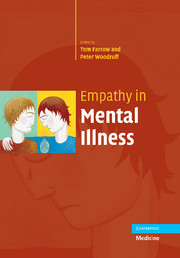Book contents
- Frontmatter
- Contents
- Foreword
- List of contributors
- Part I ‘Dysempathy’ in psychiatric samples
- 1 Empathic dysfunction in psychopathic individuals
- 2 Empathy deficits in schizophrenia
- 3 Empathy, antisocial behaviour and personality pathology
- 4 Empathy and depression: the moral system on overdrive
- 5 Empathy, social intelligence and aggression in adolescent boys and girls
- 6 Impaired empathy following ventromedial prefrontal brain damage
- 7 Non-autism childhood empathy disorders
- 8 Empathy and autism
- Part II Empathy and related concepts in health
- Part III Empathy models, regulation and measurement of empathy
- Index
2 - Empathy deficits in schizophrenia
from Part I - ‘Dysempathy’ in psychiatric samples
Published online by Cambridge University Press: 17 August 2009
- Frontmatter
- Contents
- Foreword
- List of contributors
- Part I ‘Dysempathy’ in psychiatric samples
- 1 Empathic dysfunction in psychopathic individuals
- 2 Empathy deficits in schizophrenia
- 3 Empathy, antisocial behaviour and personality pathology
- 4 Empathy and depression: the moral system on overdrive
- 5 Empathy, social intelligence and aggression in adolescent boys and girls
- 6 Impaired empathy following ventromedial prefrontal brain damage
- 7 Non-autism childhood empathy disorders
- 8 Empathy and autism
- Part II Empathy and related concepts in health
- Part III Empathy models, regulation and measurement of empathy
- Index
Summary
Introduction
Schizophrenia affects about 1% of the population worldwide and its symptoms typically manifest in early adulthood (Jablensky et al., 1992). Schizophrenia was first described by Kraepelin as dementia praecox and was re-designated as a disintegrative illness by Bleuler. Within this illness, the distinctiveness of paranoid, hebephrenic (disorganized) and catatonic subtypes has been continuously recognized from the time of Kraepelin, and is included in schizophrenia diagnosis in current diagnostic systems (American Psychiatric Association, 1994). Previous research on schizophrenia heterogeneity has emphasized the subtypes, focusing on paranoid symptoms (in a paranoid/non-paranoid distinction) thought disorder (in a thought-/non-thought-disorder distinction) and negative symptoms (in positive/negative and deficit/non-deficit distinctions), each of them being a cardinal feature of the classical subtypes. Nonetheless, patients often present with different combinations of symptoms with varying degrees of severity, stability and co-morbid features (Kraepelin, 1922). The aetiology(s) of this disorder has not yet been fully elucidated. It is possible that an additive effect of multiple genes confers susceptibility to schizophrenia, and that this vulnerability may interact with environmental factors (Tsuang, 2000).
Marked impairment in social functioning is a diagnostic feature of schizophrenia, and is one of the most disabling clinical features of the schizophrenic illness (American Psychiatric Association, 1994). An empathy deficit may underlie impaired social functioning in schizophrenia, as empathy mediates the understanding of others in social interactions, by representing or simulating other people's thoughts and feelings within the self.
- Type
- Chapter
- Information
- Empathy in Mental Illness , pp. 17 - 32Publisher: Cambridge University PressPrint publication year: 2007
- 4
- Cited by

